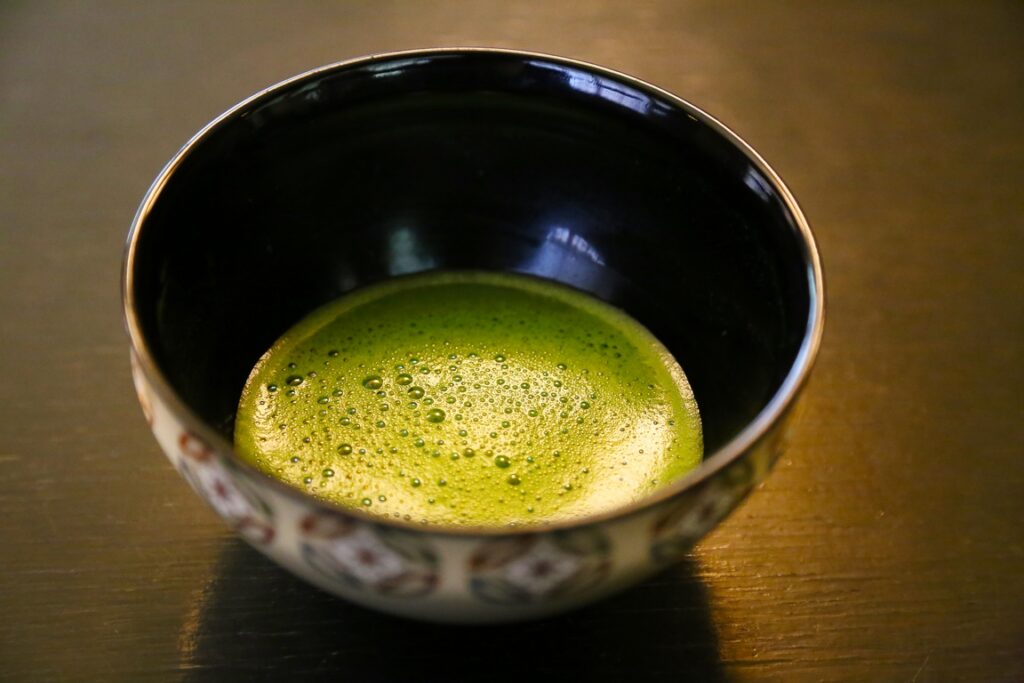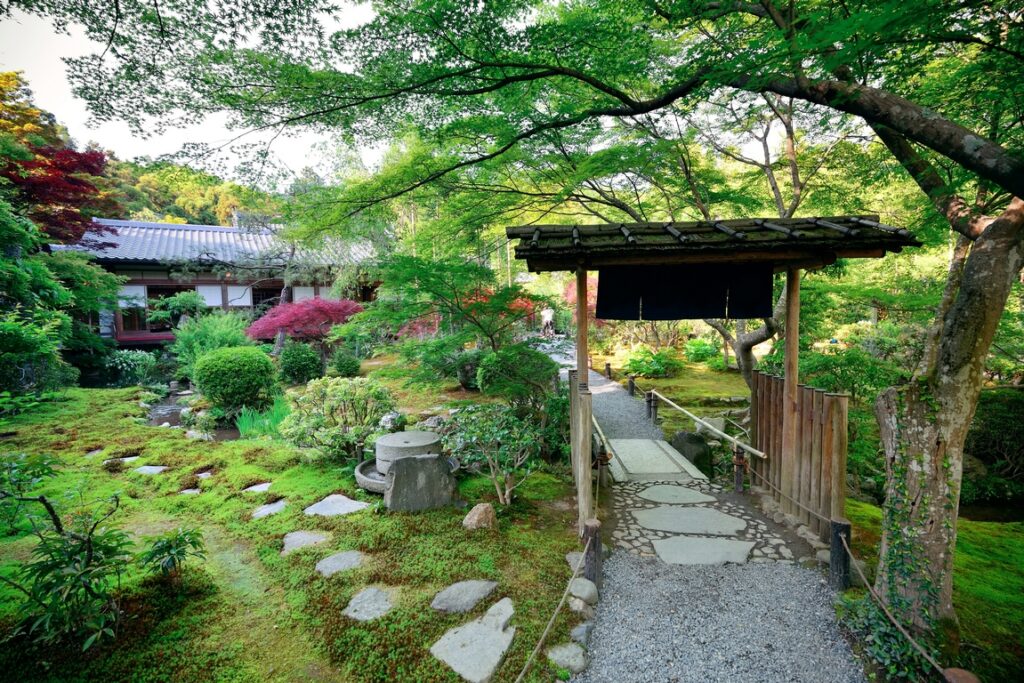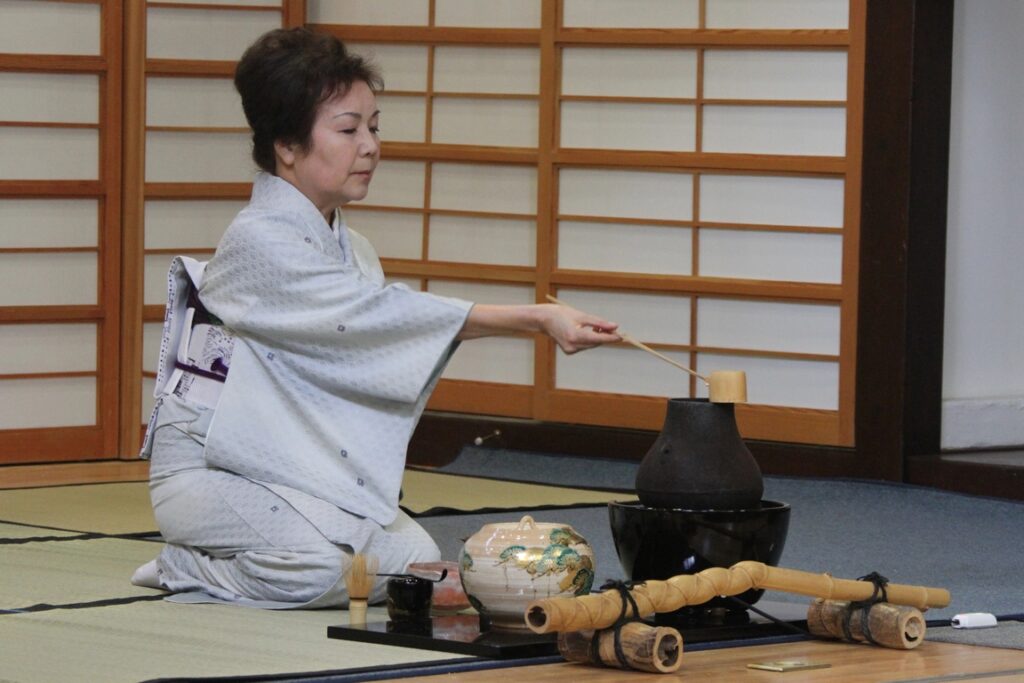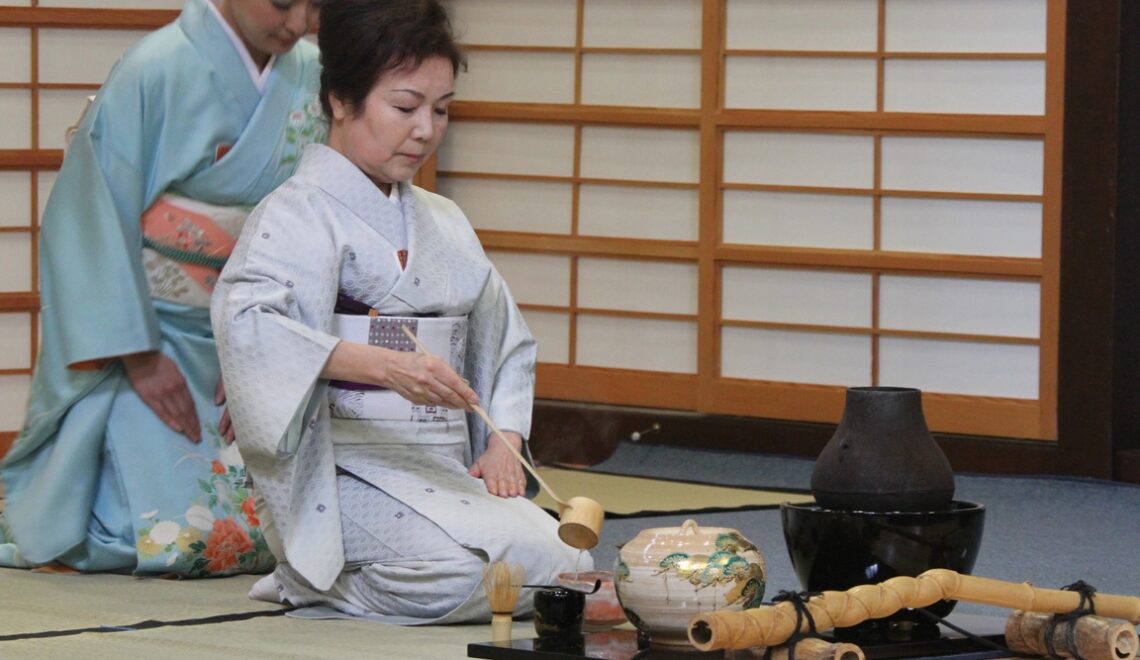
In Japan, it is called chanoyu or sad?. Chanoyu literally means "hot water for tea" and usually refers to the ceremony itself. The tea ceremony, a moment of sharing, is part of the wider philosophy of sad? or chad? The Way of Tea (1). This is a traditional art, influenced by Taoism and Zen Buddhism, in which powdered green tea, or matcha, is prepared in a highly codified way by a tea master after many years of apprenticeship.
Every Saturday for the past twenty-five years, Noriko Morishita has been going to her chanoyu class. "I enter a silent room that opens onto the garden. I sit on the tatami, boil the water, prepare the tea, then drink it. That's all there is to it. I repeat these gestures, nothing else. That's what the tea ceremony class is all about. [Even today, I often make mistakes in the order of the gestures I have to perform", reveals this practitioner of the Way of Tea in her account, "The Tea Ceremony" (2). There are so many rules and codes to learn, depending on the season, the weather, traditional festivals? So many gestures to learn, incorporate and forget. So much time, patience and willpower are needed to grasp the goal of this meditative, Zen and secular ritual, which is to live fully in the present moment. "At first, you don't understand anything about what you're doing. But one day, suddenly, you embrace a much broader perspective. It feels like life.says Noriko Morishita.
A ritual inspired by Zen Buddhism
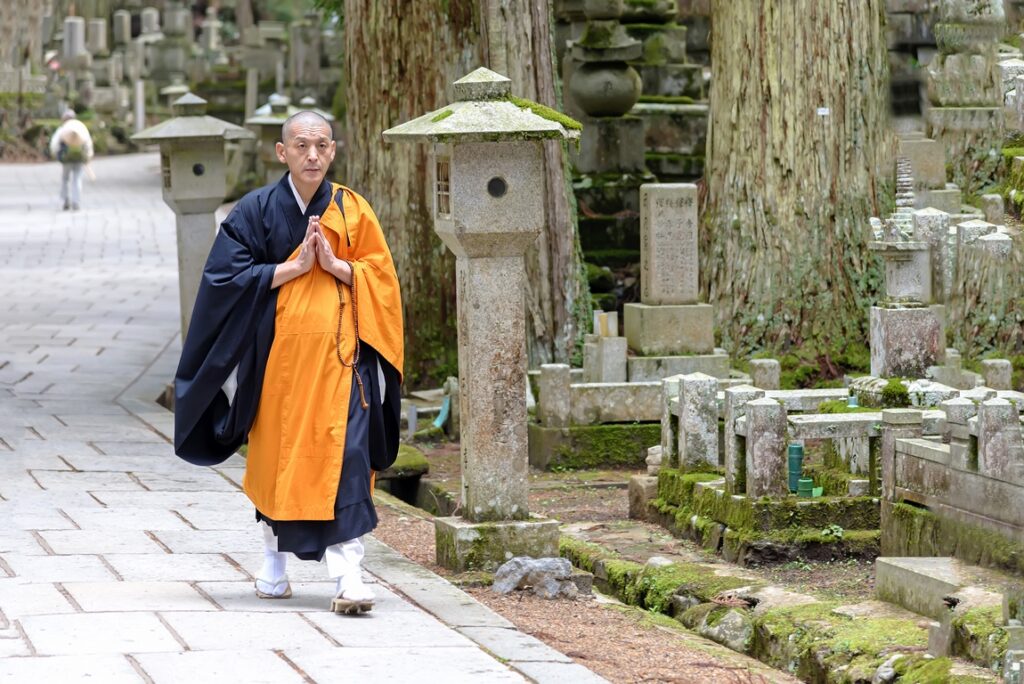
Being a chajin - a practitioner of the Way of Tea - is not something you can improvise. It is a long, arduous and costly path, an art in which all the senses will develop over the course of the sessions, according to a rigorous and imposed etiquette, both for the tea master and for the guests.
Tea was introduced to Japan from China in the 11th century, but the craze for this beverage began in earnest in the 12th century with the monk Eisai, who had studied the most recent currents of Buddhism, in particular Zen, and brought back tea seeds from the Middle Kingdom.
This art of drinking tea first developed in monasteries and was inspired by the Zen monks? ritual of drinking tea one after the other from a bowl in front of the statue of Bodhi Dharma. Before spreading to the nobility who frequented these places, and then to the samurai caste, who had no access to the other prerogatives of the aristocracy. But their libations (chakai) were exuberant, a far cry from the ceremony and ritual instituted in the 15th century by the master Murata Shuk? in reaction to these licentious banquets. Murata Shuk? laid the foundations of a sober and uncluttered Way of Tea, the Wabi-Cha. He enunciated the four values that should enable awareness of the moment and self-transformation: harmony, respect, purity of body and mind, and tranquillity. But it wasn't until the 16th century that the great tea master Sen no Rikyû, more commonly known as Rikyû, established this enduring tradition. He established the spiritual principle now known as wabi-sabi: simplicity and the art of imperfection. Following his death by hara-kiri, after a final tea ceremony to which he had invited his friends, three schools of tea, all run by his descendants, came into being: omotesenke, urasenke and mushakojisenke, the urasenke school being the most widespread in Japan today.
Connecting with nature and feeling
This secular Zen meditation ritual is performed by both men and women in a tea pavilion. It is reached via an alley (roji) through a garden, to The Tea Room is designed to "break all links with the outside world and prepare visitors, through a feeling of freshness, for the pure aesthetic joys that await them in the Tea Room". (3). The Tea Room (also known as the Void Room) is entered through a small sliding door, on one knee, as a sign of humility and to leave out any notion of social hierarchy between participants. And it is always on your knees, with your legs bent and your buttocks resting on your heels (posture seizaThe last guest closes the door. The space (kakoi) is open to the garden, and the chirping of birds, the dripping of water from a fountain and the rustling of the wind can be heard throughout the ceremony, which lasts about an hour. This time the guests are two young women dressed in kimonos and white tabi socks (4). They stand up and take turns gliding across the tatami mats to bow on their knees to the kakemono which hangs in the tokonoma (5). Visit kakemono is a scroll of calligraphy, often by monks, which may be a poem or a thought for meditation. Then, one by one, they go to the hearth (furo) on which a cast-iron kettle (kama) is placed. Each kneels again, bows to the furo and returns to her original position. All movements are measured, neither slow nor fast. All five senses are alert. The pavilion is bathed in soft light. Everything is sober, from floor to ceiling: ochre and limewood walls, bamboo pillars. The utensils needed for the ceremony are carefully chosen, like the imperfectly shaped raku bowls that suggest subtle beauty.
The importance of the temporal is equal to that of the spiritual
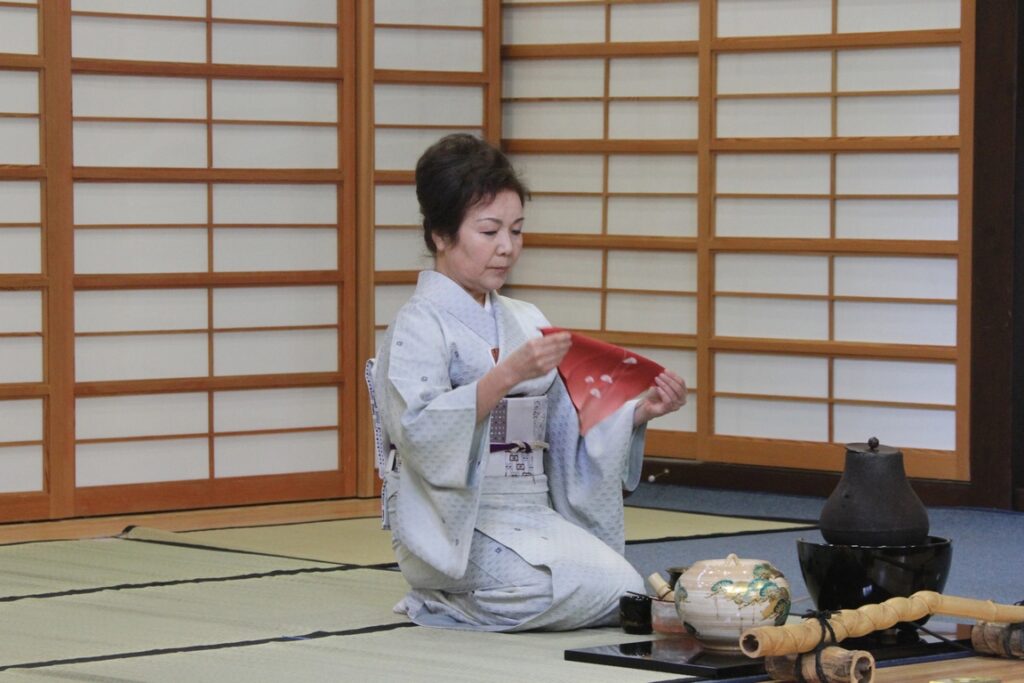
The tea mistress (Sensei), dressed in a sober parma-coloured kimono, entered when the guests were seated and placed some small cakes in front of them. The guests say thank you. She then brings the various objects that will be used during the ceremony and kneels down in front of the furo. She leaves her obi (wide belt of the kimono) a cloth (fukusa) of red silk, folding it into a triangle and folding it back on itself in a highly codified gesture, then gently wipe the tea caddy (natsume), the bamboo spatula (chashaku) used for tea, and places all the elements in front of his knees, within easy reach. The moment of contemplation is intense. Here, everything is refined and masterful without being heavy or monotonous.
Enchantment is born of movement
The Sensei raises the fukusa the lid of the kettle from which a few wisps of steam are escaping, pours a little hot water with the bamboo ladle into one of the bowls, takes the whisk (chasen) and gently place it in the bowl (chawan), then turns and lifts it three times to check its condition before whisking the water briskly and emptying it into a ceramic container for the waste water. She carefully wipes the bowl with a white linen cloth (chakin), greets her guests with a bow, then takes the matcha from the lacquered tea caddy with the spatula and places it in the bowl.
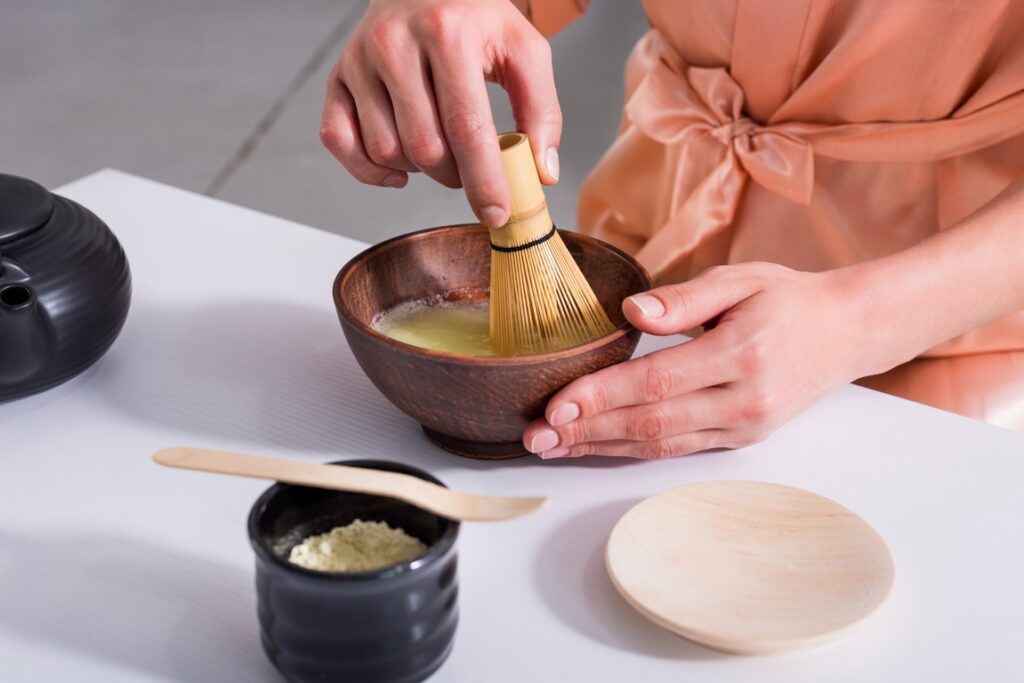
The guests enjoy their cake while the master of ceremonies pours the hot water over the tea, whips it quickly, grabs the bowl and turns it twice on her open palm to face the guest. The guest then kneels down, takes the bowl and greets the teacher, who greets her back, palms resting on her knees, fingertips outstretched and resting on the tatami.
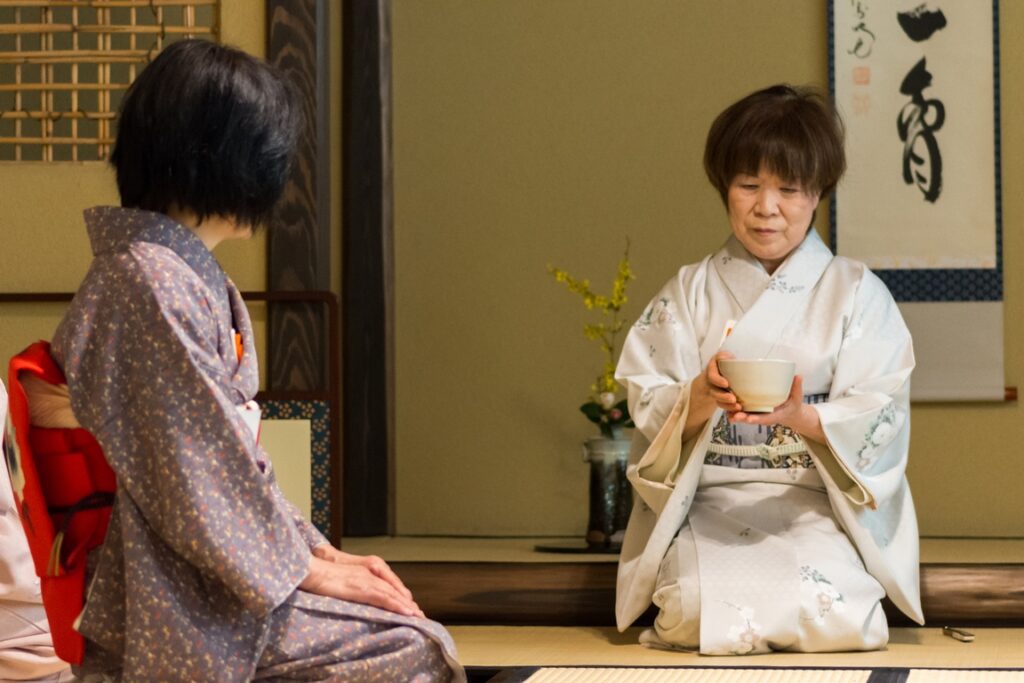
The guest raises the bowl to admire its aesthetics, swirls it three times in her palm, before gently bringing it to her lips, holding it with both hands. She drinks the tea in three gulps, making a slight sucking noise as she takes the last sip. "to mark the end of the tasting".says Noriko Morishita. The atmosphere is solemn, the gestures precise. The master of ceremonies prepares a second bowl, always without haste, with great respect for the objects she uses, which may vary from session to session. The sequence of gestures is fluid and ethereal, like a calligraphy exercise in space. "You feel like you're watching a dance".says Noriko. After drinking her tea, the first guest puts the bowl down next to the teacher and takes the other bowl of tea to put it in front of her friend, who repeats the same gesture? "Be completely here; put your heart into everything you do".Noriko's Sensei recommends to her pupils. Meticulous movements, rehearsed a thousand times. "Don't think, don't memorise gestures, trust your hands".. Training means watching and repeating a thousand times. Until "the hands start moving by themselves!
It's hard to sum up how this art unfolds without giving it away. With years of practice, the tea ceremony teaches us to live in the present, in true communion with the tea master, the guests, the elements and nature. "Listen to the rain when it rains. Be fully where you are, with all your body, with all your soul. Savour the present moment with your five senses. Then you will understand. Deliverance is here, in front of you, right now.Noriko reveals. This is what the Way of Tea leads to. It allows you to develop an extraordinary state of alertness and attention, a full awareness of the moment. More than just a beverage, tea gives life to a school of poetry and beauty, and a discipline for the conduct of life.

- The ideogram d? means way, road, teaching and principles. It is found in the names of martial arts: jud? or kyud?
- The Tea Ceremony Or how to learn to live in the moment, Noriko Morishita, Marabout, 2019.
- The Book of Tea, Okakura Kakuzo, Citadelles & Mazenod.
- Tabi shoes have the unique feature of separating the big toe from the rest of the toes. This separation allows them to be adapted to traditional Japanese shoes such as geta. In Japan, people remove their shoes on the doorstep before entering a house.
- Le tokonoma is a small, raised tatami alcove where the kakemono and sometimes a floral arrangement (ikebana) for "the edification of guests", notes Okakura Kakuzo. This space appeared in palaces in the 16th century, at the back of a room designed to receive guests and where the shogun stood. It was inspired by the altar in a Zen chapel.
Read more : Poèmes du thé - Sen no Rikyu, Editions Alternatives.
Text : Brigitte Postel
Photos : Depositphotos

